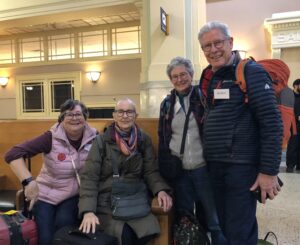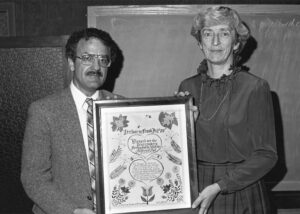Every year at Remembrance Day and Peace Sunday, Canadian Mennonites are torn between honouring those who lost their lives through war and entering into a ritual that celebrates violence as a way of resolving international conflict. In doing one, do we negate the other?
We have attempted compromise by wearing, instead of the poppy, a peace button that proclaims: “To remember is to work for peace.” And every year we struggle with that compromise, this year being no exception, with a rigorous discussion on social media as to the merits of the peace button. Are we still tilting the narrative too much toward celebrating war, rather than witnessing to peace as the better alternative? Or are we still dishonouring the dead by suggesting there is a better way? Are we exploiting these patriotic rituals to bring our own countercultural message?
Some settle their consciences by wearing both the poppy and the Mennonite Central Committee peace button. Others of us, conflicted by the matter, wear neither, and pray for peace instead in silent reflection. Listening to the intensity of feelings on both sides of this conversation, it is doubtful that we will ever come to a resolution on the matter.
What is more important at this juncture in history is to understand and respond to the ever-evolving meaning of war and peace. Regarding war, despite the fact that there are still more than 37 separate wars going on globally in 2015, and despite the fact that over the past five years there has been a dramatic increase in organized violence, especially in the Middle East, the world is much less violent than during the Cold War and the World Wars of the 20th century, according to the Uppsala Conflict Data Program.
So maybe, hopefully, world leaders are seeing that war is less and less the answer in resolving conflict, and are turning more often to diplomacy and international aid as a solution.
Likewise, peace as a core Anabaptist belief and practice is evolving. It is more than pacifism. No longer seen as mostly a negative response to war and armed conflict, we are seeing it more and more as a positive force in our world. We view peace in many more dimensions than primarily opposing war, as in conscientious objection to war and seeing ourselves as an historic peace church, compared to other communions who see war as a “necessary evil.” Many of them have believed in a “just war,” such as the Second World War, when the violent take-down of an “evil” Hitler, for instance, was seen as a redemptive act.
But while honouring our own conscientious objectors of the World Wars, as Conrad Stoesz, a denominational archivist, is doing with a forthcoming documentary on our “peace heroes,” we are rightfully expanding our view of peace to such things as becoming activists in climate change, for instance.
It is more than raising our own awareness and practices, such as turning off the lights or installing solar panels on our roofs, riding bicycles instead of cars, or signing a “fossil-free memo”—as good as these measures are. It is, as Mark Bigland-Pritchard, a Mennonite activist from Saskatchewan, says, we need to move beyond individual and congregational practices to pressure our local and federal politicians to enact legislation that will see CO2 emissions gone in five years to avoid a global catastrophe.
Or with the world’s growing refugee crisis, we need to likewise encourage government action in order to find homes, medical aid, education and jobs, in addition to opening many of our homes to these families. Standing with them is important, but our efforts need to be expanded by wider action of community groups and provincial and federal agencies.
At the forefront of an expanded peace initiative is the creation of the Centre for Peace Advancement at Conrad Grebel University College, discussed in our feature on page 4 by its director Paul Heidebrecht. Calling it a peace “incubator,” its developers are convinced that “new approaches to advancing peace in our world need to be nurtured with intentionality and purpose.” Its vision is to use Mennonite approaches to peacebuilding by using the tools and resources of innovation ecosystems.
This is a strong example of pushing our historic belief and practice of peace into new frontiers in the 21st century while keeping it within the framework of what Jesus taught us: Love our enemies, do good to those who persecute us, and love our neighbours as ourselves.







Leave a Reply
You must be logged in to post a comment.